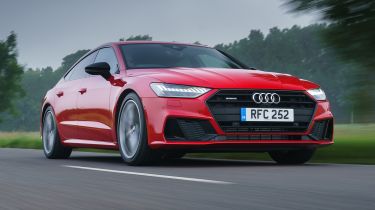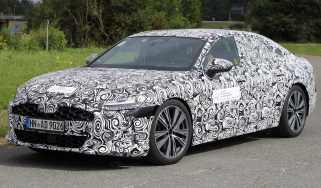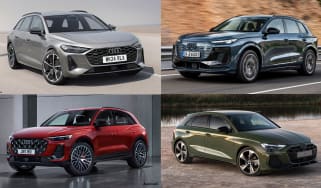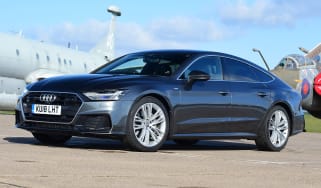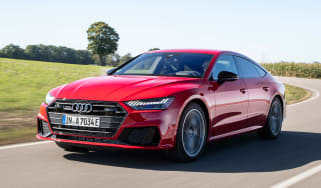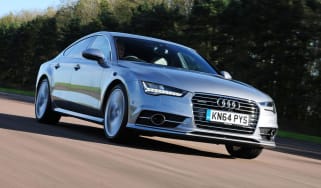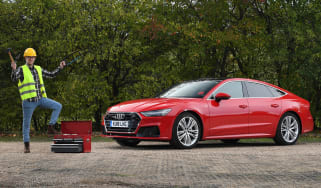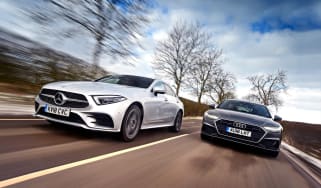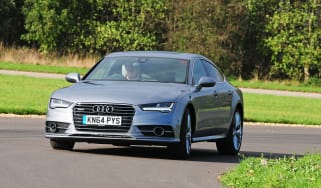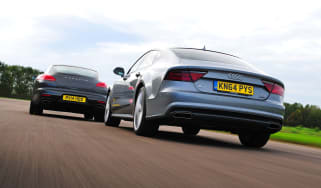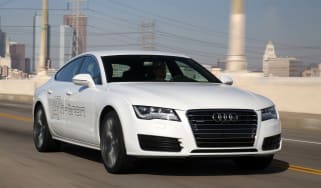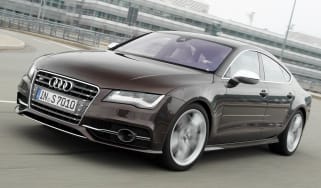Audi A7 Sportback review: great to look at but so-so to drive
The Audi A7 Sportback blends style with a decent amount of substance, but it’s not the most engaging driving experience

The Audi A7 Sportback adapts the formula of its predecessor to make a more resolved and desirable package. Not only is the design more cohesive and appealing, but the car is also lighter and better to drive. The interior also moves the game on in terms of design and technology, with a range of clever autonomous features and slick displays that help to justify the A7’s high-end market position.
The A7’s petrol and diesel engines are strong performers, and thanks to mild-hybrid tech, the official economy figures are impressive. The drive majors on maturity, refinement and composure, although that does mean the A7 isn’t as engaging to drive as a Porsche Panamera. However, there’s little doubt that the A7 is still an appealing prospect.
The Audi A7 Sportback sits on Volkswagen Group’s MLB Evo platform, closely related to the A6 and flagship A8. Unlike its saloon siblings, this car has a sporty appearance courtesy of its wide, long and low dimensions.
The starting price of around £58,000 puts it towards the higher end of the executive car class, with rivals including the Mercedes CLE. Moving up the range to the sportier S7 Sportback pushes the starting price to almost £78,000, which pits it against the likes of the BMW 8 Series and Porsche Panamera, while the full-fat RS 7 Sportback commands nearly £120,000.
Used - available now
Compare the A7 Sportback to the Audi A6 saloon, and the Sportback carries a premium of around £10,000 when looking at like-for-like models. Like the A6, there are Sport, S line and Black Edition trims.
Sport models get 19-inch wheels and plenty of standard kit, including leather, LED headlights, Audi's MMI infotainment system with Virtual Cockpit digital dials and twin touchscreens for navigation and climate controls and a rear camera.
Opt for the S line, and you’ll get bigger 20-inch wheels. There's also sportier-looking exterior styling, firmer sport suspension, privacy glass and part-Alcantara trim.
Black Edition cars include a styling pack in the aforementioned colour, unique 20-inch wheels and a flat-bottomed steering wheel.
The sportier S7 line-up starts with the Black Edition. This includes 21-inch alloys, sports seats, adaptive suspension and Audi’s Technology Pack. The other option is the range-topping Vorsrpung version, which adds adaptive air suspension, all-wheel steering, LED matrix headlights, a Bang and Olufsen sound system, leather upholstery and a panoramic sunroof.
The six-figure RS 7 has three trim levels: performance, performance Carbon Black and performance Carbon Vorsprung. The entry-level model includes 22-inch alloy wheels, RS-tuned air-suspension, a sports exhaust, and laser light LED headlights. The Carbon Black edition adds a custom styling package, Dinamica headlining, and an RS-themed interior. The top-end Carbon Vorpsrung goes even further with Audi’s Tour and City Assist packs, Dynamic Ride Control and a panoramic roof.
Power for the A7 Sportback comes from a 2.0-litre 40 TDI diesel and a 2.0-litre TFSI 45 petrol engine, and both of these use mild-hybrid technology to boost efficiency. The TDI unit produces 201bhp and 400Nm or torque, while the TFSI petrol puts out 261bhp and 370Nm.
Alternatively, there’s also the option of the Audi A7 TFSI e. The 50 TFSI e is a plug-in hybrid powered by a 2.0-litre petrol engine and an electric motor, with an overall fuel economy figure of up to 201.8mpg. Of course, this figure will be difficult to reach in the real world, but a CO2 emissions figure of just 31g/km makes this the most suitable A7 for use as a company car.
For those who prefer performance, there’s the option of the S7 Sportback. This uses a 3.0-litre V6 TDI diesel engine to make 340bhp and 700 Nm of torque, resulting in a 0-62mph time of 5.1 seconds. The hardcore RS 7 Sportback uses a 4.0-litre V8 petrol engine, producing 621bhp and 850Nm of torque. The five-door coupe will trouble most supercars in a straight line, reaching 62mph in just 3.4 seconds.
Engines, performance and drive
The old Audi A7 Sportback was a comfortable and capable cruiser, but didn’t feel particularly sporting or agile. Audi has tried to address that with the second-generation car, introducing weight-saving measures and driving aids, such as four-wheel steering. The latter can turn the rear wheels up to five degrees in the opposite direction at low speeds to make the car easier to manoeuvre, and two degrees in the same direction at higher speeds to make it feel more stable.
The A7 certainly feels sharper than an A8 from the off, with less body movement and more direct steering providing greater agility. The ride isn’t perfect, especially at low speeds. If you value comfort, stick with the entry-level Sport because that has a softer suspension set-up than S line models that get firmer sports suspension as standard. The quattro all-wheel drive system is standard across the range, and provides all the traction you’ll need, whatever the weather. The A7 is confidence-inspiring and easy to place on the road, but it never feels like a car you’d drive purely for the enjoyment of doing so.
It’s not exactly an all-out thrill machine, but the A7 impresses greatly as a motorway cruiser. The engines are hushed, while wind and road noise are well isolated. It’s a great car to dispatch miles in at speed.
The S7 sharpens things up over the standard A7, helping to make it more enjoyable to drive. Adaptive suspension is standard so that you can tailor the ride depending upon the road conditions, although it can be jiggly at low speeds. The handling is impressive, though. Thanks to the inclusion of four-wheel steering on Vorsprung trim, the S7 feels agile and well-balanced. The steering is light and offers little feel, though, so ultimately, it’s still not much fun.
Engines
Throughout its lifetime, the A7’s core engine range has varied in size, but today, it includes a single petrol and diesel, along with a plug-in hybrid. The 2.0-litre 40 TDI diesel produces 202bhp and 400Nm of torque and is mated to a seven-speed S Tronic automatic gearbox. The 45 TFSI petrol is also a turbocharged 2.0-litre unit, which pumps out 262bhp and 370Nm of torque.
Both of these engines also use Audi’s 48v mild-hybrid system, which uses a belt-driven alternator starter that recuperates energy under braking or when coasting and stores it in a lithium ion battery pack under the boot floor.
The system allows the engine to be shut down when coasting at speeds between 34mph and 99mph, and also means the stop/start system can activate while the car is still rolling to a stop. It has little impact on the overall driving experience, however.
These 2.0-litre engines offer improved running costs at the expense of performance, but they're by no means slow. The 262bhp 45 TFSI manages 0-62mph in 6.2 seconds, while the 202bhp 40 TDI diesel has a time of seven seconds.
If you’re considering the Audi A7 Sportback as a company car, or just want to cut your emissions, the plug-in hybrid A7 TFSI e will be the option for you. This model comprises a 2.0-litre petrol engine working in tandem with an electric motor to return 295bhp and 450Nm of torque. This model takes 6.3 seconds to reach 62mph from a standstill and will go on to reach 155mph.
Above these models sits the sporty S7, which is powered by a twin-turbocharged 3.0-litre V6 diesel. A diesel might be an unusual choice for a performance car these days, but a whopping 700Nm of torque — as well as 339bhp — means this executive coupe will sprint from 0-62mph in 5.1 seconds.
The range is topped out by the hot RS 7. Unlike the S7, this all-out performance model relies on petrol power. Its 4.0-litre twin-turbo V8 makes 621bhp, 850Nm of torque and will accelerate from 0-62mph in 3.4 seconds. Top speed is 174mph.
MPG, CO2 and running costs
With both the petrol and diesel engines utilising Audi’s 48v mild-hybrid system, the Audi A7 Sportback line-up is reasonably competitive regarding the claimed WLTP fuel economy. Of course, the plug-in hybrid A7 TFSI e is the star of the show here.
Starting with the petrol A7, the 2.0-litre 45 TFSI has claimed economy figures of up to 36.7mpg and emissions of 188g/km. Predictably, the 2.0-litre 40 TDI diesel has the advantage when it comes to fuel economy, returning up to 49.6mph on the WLTP combined cycle. CO2 emissions start from 163g/km.
Company car users will be best suited to the 50 TFSI e plug-in model, which has a claimed fuel economy figure of up to 217.3mpg. Unfortunately, reproducing this figure in the real world will be difficult, but you can certainly expect to match or beat the diesel model’s efficiency with regular charging. The PHEV also claimed CO2 emissions of as low as 31g/km and an all-electric driving range of 41 miles. However, this model won't deliver the Benefit-in-Kind tax and running cost savings that a fully-electric car can provide.
The S7’s TDI diesel engine means it can prove surprisingly economical for a more performance-oriented model. Provided you haven’t got your right foot constantly glued to the floor, Audi claims the S7 can achieve 39.2mpg, while its CO2 emissions start from 189g/km.
The RS 7, on the other hand, is powered by a thundering twin-turbo V8 petrol, so the economy is pretty much as you’d expect. At best, you’ll be looking at 23.2mpg on the WLTP combined cycle, along with a CO2 figure of 276g/km.
Insurance
The A7s insurance groups are pretty typical for a car in this class. The 2.0-litre petrol and diesel line-up range from group 42E to 46E, depending on your chosen trim level. The plug-in hybrid TFSI e is pricier, ranging from group 47E to 50E. Unsurprisingly, the S7 and RS 7 both sit in group 50E. In comparison, the Audi A6 line-up starts much lower down in group 33E.
Depreciation
Our expert data suggests that the Audi A7 Sportback should retain between 38-43 per cent of its value over three years/36,000 miles. The plug-in hybrid models find themselves at the bottom of this range, while the petrol and diesel models stay above 41 per cent. Be careful with the options list, however, as it’s easy to add thousands to the car’s list price that you won’t recoup come resale time.
To get an accurate valuation on a specific model check out our free car valuation tool...
Interior, design and technology
The second-generation Audi A7 Sportback is now one of the longer-serving members of Audi’s line-up, but this curvaceous four-door coupe still looks appealing and fresh.
Several details, such as the extra-wide grille, sleek-looking headlights, and prominent styling lines, help it look the part, but the large, distinctive, single-piece OLED rear light bar really marks it out. The clever light ‘animations’ when you lock or unlock the car are either very cool or a bit showy, depending on preference. If you’re getting a move on, the rear spoiler pops up at speeds of over 75mph.
Inside, the A7 adopts the same minimalist approach as its larger A8 sibling, but there’s a bit more of a driver focus thanks to the angled dash and lower, sportier driving position. The slick-looking dual-screen infotainment system controls almost every aspect of the car’s comfort and infotainment functions, including Audi’s Virtual Cockpit system.
Sat-nav, stereo and infotainment
The dual-screen infotainment system is clever, sharp, and instantly impressive. The touchscreen surfaces are haptic, delivering feedback to the touch when pressed. It means that instead of tapping lightly, as you would on a tablet or smartphone screen, you have to press the screen like it's a button. But once you’re used to it, it’s a great set-up to use. It’s probably still beaten for ease of operation on the move by a good old-fashionedd rotary switch, though.
As you’d expect, the quality of materials and fit and finish is mainly faultless. The quality really matches the flagship A8, though the layout and the design is a bit sportier compared to the firm’s luxury limo.
Practicality, comfort and boot space
By their very nature, big four-door coupes are less practical than the saloon models on which they are based. But the Audi A7 Sportback is better than you might expect, with plenty of space for four adults to get comfortable — or five to squeeze in for short journeys. Those frameless windows for the door glass help with access.
Visibility is a little compromised thanks to thick pillars and that sloping roof, but it’s no worse than in a Porsche Panamera. The multitude of cameras and sensors make parking easier than it looks, while the self-parking function will make the process a doddle.
Dimensions and size
The A7 Sportback is 4,969mm long, 1,908mm wide and 1,422mm tall. It’s ever so slightly shorter than the old model, but it’s fractionally wider and taller. Audi has added 10mm to the wheelbase despite the shorter length and increased the overall cabin length by 21mm, improving passenger space. The A8 is a good 200mm longer still, however.
Leg room, head room & passenger space
You’ll be pleasantly surprised by the space on offer. Front seat passengers get loads of head and leg space, with supportive and endlessly adjustable seats. Legroom is improved for rear seat passengers over the old car, and while six-footers will find their heads brushing against that sloping roofline. It’s not too bad overall and hardly what you'd call cramped.
Boot space
One practical benefit the A7 has over its saloon siblings is its hatchback-style tailgate. It makes accessing what space there is significantly easier for those awkwardly shaped loads. The 535-litre boot is identical in capacity to the previous generation A7.
All cars get a power-assisted tailgate, so all you need to do is press a button, and the hatch will open or close by itself.
Reliability and safety
The A7 Sportback shares the same MQB Evo platform as the A8 limousine and A6 saloon, as well as several other Volkswagen Group cars. While these underpinnings are pretty well proven, this is a mechanically complex model, so big bills could quickly start to appear if things do go wrong.
Audi’s reputation for reliability isn’t perfect, either, with the brand only ever getting middling scores in our Driver Power customer satisfaction survey. The A7 didn’t appear in our most recent survey, but customers rated Audi in a pretty damning 30th place out of 32 brands in our best manufacturer rankings.
The A7 was tested by Euro NCAP in 2018 and achieved top marks for safety. Adult and child occupant protection was rated at 93 per cent and 85 per cent, respectively.
Warranty
The A7 is covered by Audi’s standard three-year, 60,000-mile warranty, which can be extended to four years or 75,000 miles, or five years and 90,000 miles for an additional cost. Given the complexity of the car and the cost of any potential repairs, this could prove to be a wise investment.
Servicing
Audi offers the choice of a fixed inspection or flexible servicing schedule, depending on your intended mileage. Fixed inspection is aimed at those doing less than 10,000 miles a year and it includes an oil change service every year or 9,300 miles and a full inspection service every 18,600 miles or two years.
If your mileage is likely to be higher than that, you can select the flexible schedule, with the car’s computer deciding when it needs to be serviced based on usage and other parameters. The variable intervals are up to a maximum of 18,600 miles or two years.
Frequently Asked Questions
More reviews
Car group tests
In-depth reviews
Long-term tests
Which Is Best
Most Economical
- Name50 TFSI e Quattro Black Edition 5dr S Tronic
- Gearbox typeSemi-auto
- RRP£74,140

